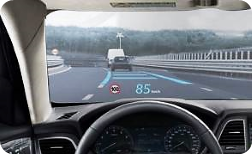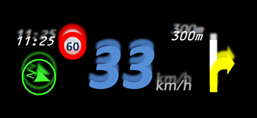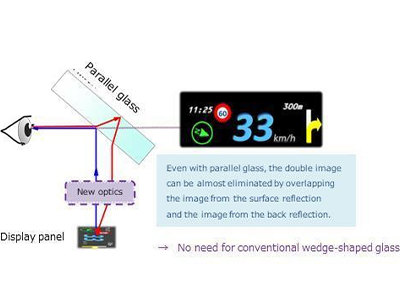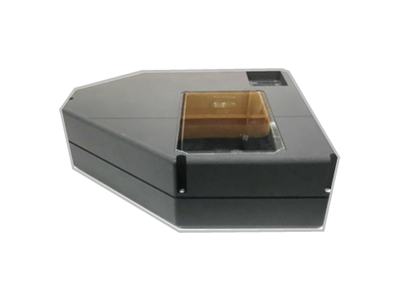Development of New Technology to Reduce
Double Images on Head-Up Displays
Technology that does not require conventional special glass
and can be mounted on already sold vehicles
JVCKENWOOD Corporation (JVCKENWOOD) has developed a technology to reduce double images generated on the front and back surfaces of windshields without using conventional special glass for the Head-Up Display (hereinafter “HUD”), which is becoming more popular as an ADAS*1.
Development Background
HUD is a display device that displays speed, car navigation, and other information necessary for the driver on the windshield so that the driver can check instruments while keeping their eyes on the road. It is expected to further develop as an ADAS by being integrated with advanced technologies such as automatic driving and AR*2.
On the other hand, there is an issue with low visibility due to the structure of the windshield, and we have developed new technology to solve this problem by utilizing video technology, optical technology, and in-car technology we have cultivated over many years.
*2: Augmented Reality.

HUD image
Features of the New Technology and Future Initiatives
Conventional HUDs display images by projecting them from the dashboard using reflection on the windshield. However, since a reflective film cannot be added to the glass surface because it would obstruct the front view, the surface reflection of the glass itself*3 must be used, and the reflection on the back surface of the glass causes a double image*4. In order to prevent this, it is necessary to use special wedge-shaped glass with a slight angle on the front and back surfaces. However, not only must it be mounted on the vehicle assembly line, but it also increases the cost of the windshield.

Double images
Our newly developed technology is designed to optimize the optical paths of the surface and back reflections of the glass, thereby largely achieving a balance between the condition of aligning the optical axes of the front and back reflections of the parallel glass*5 used in windshields and the conditions such as position, distance, and angle of view of the displayed image required for a HUD. The result is a HUD display that is more comfortable in terms of human visual characteristics. In addition, unlike the conventional methods of adding a new optical component to a concave mirror, this technology enables a reduction in double images with the same optical component structure as the conventional HUD. This eliminates the need for expensive wedge-shaped special glass and reduces costs for the total HUD system. Therefore, this technology is expected to be applied to low-priced vehicles, as well as to be mounted outside vehicle assembly lines because conventional windshields can be used.
By further promoting the development of this technology, we aim not only to provide this technology to the Aftermarket Business, automakers, and in-car device manufacturers, but also to expand it to non-automotive applications such as entertainment and signage.
*3: Attaching objects that obstruct the view of the windshield is regulated by law.
*4: This occurs on parallel (non-wedge) glass. For vehicles actually shipped, countermeasures are taken in combination with special wedge-shaped glass, which usually prevents double images.
*5: When the conditions of this technology are applied to the optical design of conventional concave mirrors, there is a trade-off in design freedom, and the visible area, driver's posture, angle of view, and image quality are affected and restricted more than before. This makes it necessary to achieve a total balance of these factors in the final design.

Conceptual image of the elimination of
double images using new technology

Developed prototype
Intellectual Property Initiatives
We are pursuing patent application and registration in Japan and overseas for the principles and implementation methods of this technology.
11 patents registered and 7 applications pending in Japan
18 patents registered in total overseas (Europe, the United States, China, and South Korea)
*As of April 1, 2021
This document is based on the information available to the Company at the time of release and may differ from the latest information.


*1: Advanced Driver-Assistance Systems.